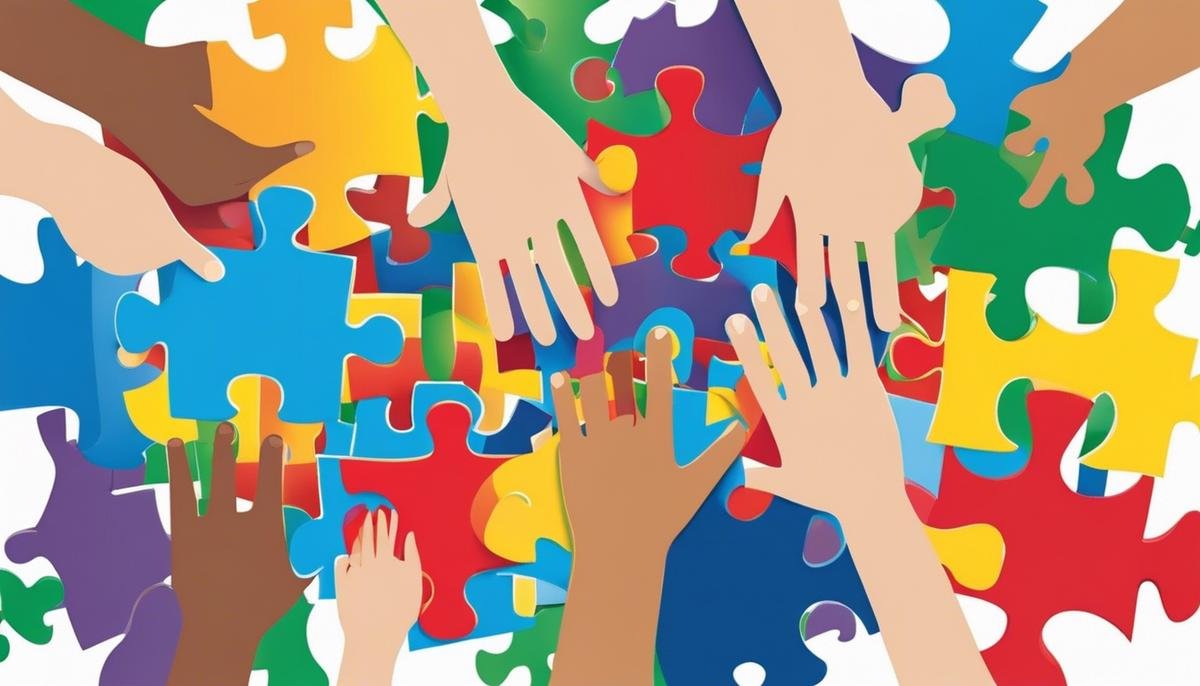
The subject of Autism, a neurodevelopmental disorder experienced by numerous children worldwide, invites essential discussions due to its diverse manifestations and potential influence. This analysis seeks to garner understanding about Autism by exploring its core aspects, common indicators, and different categories. Of particular emphasis, however, is the prevalence of Autism in African American children—an exploration that unveils the degree of occurrence and the key factors contributing to these statistics. By interpreting data from research studies and highlighting potential environmental, genetic and social factors, a more comprehensive picture emerges. Additionally, a closer look at the diagnosis process for African American children casts light on potential challenges. The discourse culminates in cogitations on Autism advocacy, underlining the need for increased awareness and more inclusive environments.
Understanding Autism
Understanding Autism and Its Presentation in Children
Every child is a special gift, each one unique and irreplaceable. As diligent parents, it’s always in our best interest to understand and appreciate our little ones and their unique mannerisms and behaviors. One such important topic we must take time to understand is autism.
Autism, or Autism Spectrum Disorder (ASD), refers to a group of complex neurological development disorders. ‘Spectrum’ denotes a wide range of symptoms, skills, and levels of functioning involved. Settling in early during childhood, autism lasts through a person’s lifetime. It affects every one in sixty-eight American children, according to the Centers for Disease Control and Prevention (CDC).
Recognizing the symptoms of autism early in a child’s development can help parents seek out sources of support as soon as possible. While it can’t be emphasized enough that every child is different, some broad patterns can signal the presence of autism.
Perhaps one of the most common traits is difficulties with social interaction. Children with autism might struggle to maintain eye contact, have trouble reading social cues, or demonstrate a lack of awareness of the feelings of others. They might prefer solitary play and have a hard time making friends.
Communication is another key area affected. While some children with autism might start talking later than their peers, others might not develop spoken language skills at all. For those who do talk, they might use a monotone pitch or repeat phrases and sentences.
Children with autism also often engage in repetitive behaviors. This could include rocking back and forth, lining up objects, or becoming overly attached to specific toys, characters, or topics. They also have a strong preference for routine and can react negatively to even minor changes.
Additionally, sensory sensitivity is common among children with autism. They might overreact or underreact to sensory input, such as sounds, lights, touch, or texture. It may also lead to picky eating habits due to sensitivity to specific tastes and textures.
While these are general indicators, remember that no child with autism is alike. Some may have mild symptoms, while others may have more severe signs. It’s also worth noting that just because a child exhibits some of these behaviors, it doesn’t mean they are on the spectrum. Only a trained professional can make a diagnosis.
If you observe these characteristics persistently in your child, it’s wise to consult with a healthcare professional for guidance. They can provide a comprehensive evaluation and suggest appropriate interventions for your child’s well-being.
Raising a child with autism presents its own unique joys and challenges. But with love, understanding, and an informed perspective, you arm yourself with the knowledge and patience to help your child navigate through life in the most enriching way possible.
Remind yourself: Every child has their own journey and strengths, and your love is their biggest influencer and advocate. You’re never alone in this journey; reach out to the caring community of parents who have shared similar experiences. Together, we can learn, grow, and provide the best for our beautiful children.

Prevalence of Autism in African American Children
Autism Prevalence in African American Children Versus Other Groups: A Closer Look
Autism Spectrum Disorder (ASD), an umbrella term for a set of neurological and developmental disorders, is diagnosed in individuals across diverse ethnic and racial backgrounds. There is not one population group that is immune to these disorders. With that said, prevalence rates can and do differ among various groups. Discussions about ASD prevalence often bring up a critical question: how prevalent is ASD in African American children compared to other groups?
Released in March 2020, The Centers for Disease Control and Prevention’s (CDC) surveillance data suggests that 1 in 54 children in the US is diagnosed with ASD, portraying an increase from the previous data. Yet, if we contemplate these figures against a racial and ethnic backdrop, the details shape a new narrative.
African American children were once believed to have lower autism prevalence rates than their Caucasian peers. However, recent studies show that these rates may in fact be neck and neck. The confusion largely stems from an under-diagnosis trend within the African American community. A 2019 study conducted by researchers from Rutgers University indicated that African American children are often diagnosed with ASD later than Caucasian children, which can delay appropriate treatment and interventions.
While the reasons for this delay are complex and multifaceted, one potential factor could be the lack of cultural competency in early diagnostic tools, which have historically been calibrated towards Caucasian norms. Furthermore, socio-economic disparities and access to healthcare can also play a significant role.
When it comes to Hispanic children, data shows that they continue to have lower rates of ASD diagnoses compared to African American or Caucasian children. Again, this does not necessarily indicate a lower prevalence but may be linked to similar under-diagnosis trends, language barriers, and cultural biases present in diagnostic tools.
This information is important for all parents, caregivers, and educators. Highlighting these discrepancies underscores the need for culturally competent diagnostic tools and approaches, equitable access to healthcare, and increased awareness in all communities.
Moreover, it underscores the need for community engagement and collective advocacy. Recognizing ASD’s prevalence across all racial and ethnic groups encourages inclusive efforts to find solutions to shared challenges.
Living with autism isn’t a one-family journey – it’s a global marathon, which unites people from all walks of life. Understanding these crucial differences in ASD prevalence brings us one step closer to improved care, acceptance, and support for every child, no matter their race or ethnicity.
By shedding light on ASD prevalence discrepancies, there’s hope to bridge these gaps, leading to a more inclusive, informed society where all autistic children can thrive. As they say, knowledge is power. This power elevates not just one, but all members of the ‘tribe’ called parenthood, making the world a better place for each precious child involved.

Potential Factors Contributing to Autism in African American Children
Autism prevalence in African American children has shown to be significantly higher compared to other racial or ethnic groups. This trend raises many questions about the social, genetic, or environmental influences behind such high prevalence. Let’s dive into what might be influencing these statistics.
Basis of comparison is one potential influence. Diagnostic criteria were originally developed based on Caucasian children, thus there may be some cultural or racial bias within the diagnostic tools used. African American children may be getting diagnosed more frequently with Autism Spectrum Disorder (ASD) because they’re being compared to a largely homogeneous group.
Socioeconomic status can also be a contributing factor. African American families may experience more struggles gaining access to, affording, or receiving equitable healthcare due to socio-economic disparities. This could potentially delay diagnosis, which in turn may impact the prevalence rates of ASD in African American children.
Genetics could also potentially play a role because certain genetic factors are more prevalent in specific races or ethnicities. Moreover, research studies often exclude or under-represent minority communities, limiting our understanding of genetic links.
Then there’s environmental influences to consider. Children growing up in stressful environments may be more prone to develop ASD. Studies suggest that risk of developing the disorder can be significantly higher for children exposed to chronic stressors such as poverty, violence, or divorced parents. African American families disproportionately experience these and similar social stressors, contributing to the elevated prevalence of autism.
Last but not least, education is critical. In many communities, there is a lack of awareness and understanding about ASD, its symptoms, and the importance of early intervention. This might be more prevalent in communities of color due to language barriers, cultural differences, or limited access to resources. This represents another potential influence on higher ASD prevalence rates among African American children.
In conclusion, the higher prevalence of autism in African American children relative to other racial or ethnic groups cannot be confined to one factor. It is possibly due to a complex interplay of social, genetic, and environmental influences. The stresses of socio-economic disparities, cultural stigmas, possible genetic links, and environmental exposures all play vital roles.
It is essential to remedy the inequities limiting the access to and quality of healthcare for ‘all’ families. Continued advocacy for equal and representative research, as well as culturally competent diagnostic tools and approaches, are vital to accurately assess autistic prevalence. Knowledge truly is power – equipping ourselves with understanding puts us in better stead to foster acceptance and support for all autistic children, regardless of race or ethnicity.

Diagnosis and Support for African American Children with Autism
10. Criticality of Education and Advocacy in Minority Communities
In minority communities, it’s widespread for cultural and social factors to play a significant role in the understanding and acceptance of autism. Often, community attitudes towards autism may be influenced by stigma, fear, or simply a lack of information. To address these barriers, it’s essential to educate and advocate. Sharing accurate knowledge about autism can reduce misunderstanding and pave the way for better supports and inclusion.
11. Cultural Barriers in Diagnosis and Intervention
Cultural barriers are another significant challenge that African American families face when they are navigating the autism world. There can be a lack of culturally appropriate diagnostic tools that consider the nuances of different cultural backgrounds, which contributes to diagnostic disparities among African American children. This underscores the urgency for cultural competence in healthcare services, which means understanding and respecting different cultures during diagnosis and treatment processes.
12. Role of Support Systems and Resources
Having strong support systems and access to resources can dramatically improve outcomes for African American children with autism. Community-driven initiatives can fill in the gaps that local healthcare providers may be unable to cover. Tailored programs that understand and respect the cultural perspectives of this community are crucial in offering effective therapies and interventions. Furthermore, resources might not only include healthcare but also educational, social, and financial assistance, that can help lift families dealing with autism into better situations.
13. Importance of Early Intervention
Early intervention is the key to enabling children with autism to reach their potential. However, studies suggest that African American children are often diagnosed later than their peers, which can delay critical early interventions. Raising awareness about the early signs of autism and increasing accessibility to diagnostic services may result in earlier intervention and better outcomes for African American children with autism.
14. Necessity for More Inclusive Research
Historically, most autism research primarily focused on white children, which leaves considerable gaps in knowledge about how autism manifests among African American children. Encouraging more inclusive research that includes diverse participants can help in understanding how autism varies among different racial and ethnic groups. This, in turn, will support the development of targeted interventions and supports.
15. Advocacy for Policy Changes
To combat the health disparities faced by African American families, a robust advocacy effort at policy levels may be necessary. Ensuring that policies are in place to promote equal access to healthcare and support for all children, regardless of their race, ethnicity, or socioeconomic status, should be a collective effort. Comprehensive policies could significantly impact improving the diagnostic process and healthcare outcomes for African American children with autism.
In conclusion, diagnosing and supporting African American children with autism presents both significant challenges and opportunities. As a community, commitment to improving knowledge, raising awareness, removing barriers to diagnosis and intervention, and advocating for effective policies can make a meaningful difference in the lives of children and families dealing with autism. And while strides have been made, there is always room for growth and improvement when helping our children to lead fulfilling lives.

Promoting Awareness and Advocacy
Promoting Autism Awareness and Advocacy in the Community: Essential Steps Forward
While knowledge about Autism Spectrum Disorder (ASD) and its prevalence among children keeps increasing, it becomes urgent to translate this growing awareness into effective support systems and resources in the community, making advocacy an indispensable endeavor.
Education plays a key role in overcoming misinformation, stigma, and misunderstanding around ASD. Encouraging open dialogues about ASD in neighborhood meetings or local schools, organizing informative workshops, and circulating educational materials are potent steps towards increasing community awareness. Creating a platform for the voices of autism-affected families and individuals also bolsters understanding, allowing unique insights and experiences to replace stereotypes and misconceptions.
More often than not, cultural barriers inevitably surface and stand in the way of diagnosis and early intervention. Some cultural beliefs might downplay symptoms or attribute them to non-medical causes, while others stigmatize developmental disorders, making families hesitant to seek help. Overcoming these barriers requires culturally sensitive outreach programs and communication materials highlighting that autism is a worldwide occurrence crossing all cultural and ethnic boundaries.
Audiences must be reminded of the crucial role that support systems and resources play in life outcomes for children with ASD. This means promoting comprehensive healthcare and therapy services, educational supports, legislative protections, and community programs that foster social inclusion and independence.
Improving access to early intervention services is another significant advocacy focus. Providing families with clear guidelines about early signs of autism and the steps to take upon noticing them, can help children receive the necessary supports earlier. Building strong partnerships with local healthcare providers can also ensure referrals to intervention service providers happen in a timely manner.
Observed disparities in autism prevalence across racial and ethnic groups necessitate more inclusive research. Thus, encouraging responsible parties to carry out such studies can provide more accurate prevalence rates, improve early screening methods, and tailor intervention services to cater to diverse cultural needs.
Last but not least, advocating for policy changes is crucial to ensuring equal rights and opportunities for individuals with autism. This includes pushing for laws ensuring comprehensive healthcare coverage for autism services, mandating autism training for educators and healthcare professionals, and safeguarding against discrimination in all sectors of life.
Inclusivity, empathy, and understanding ought to lay the foundation for autism advocacy. One child at a time, one family at a time, let’s make our communities supportive spaces where children with autism, regardless of their race or ethnicity, can thrive and reach their full potential. Let’s remember that autism does not define a person – their strengths, kindness, creativity, and unique perspective does. After all, diversity adds to the richness of the community tapestry. Let’s embrace and celebrate it.

Awareness and understanding of Autism in African American children presents an opportunity for illumination and action—a chance to improve the diagnosis process, provide effective support, and understand potential contributory factors. However, it comes with a responsibility, and that is to advocate for acceptance and inclusivity for these children. Propelling change is a collective effort and is most effective when fueled by well-informed, empathetic individuals. This overview seeks to stir such a response by presenting comprehensive insights. It urges each one to act as ambassadors of change, fostering environments that celebrate differences and offer equal opportunities for all children. The impact of such awareness and advocacy extends far beyond initial perceptions, paving the way for a more inclusive society that uplifts and values every individual irrespective of their neurological disposition.




